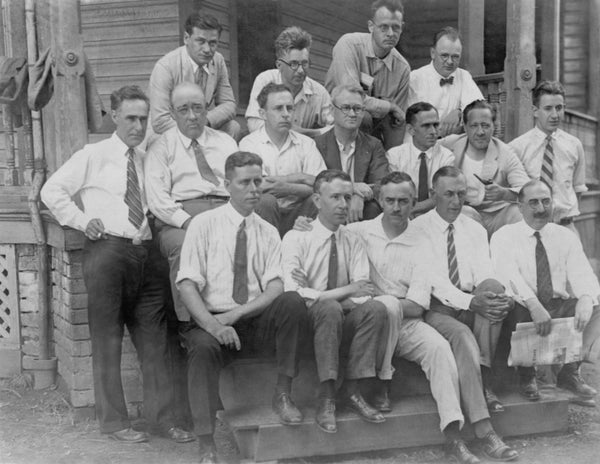Strange but not true? Did a US game publisher really get raided by US intelligence services over a fighter plane that never existed?
Strange but not true? Did a US game publisher really get raided by US intelligence services over a fighter plane that never existed?The hunt for truth in the legend of the F-19.Image credit: Eurogamer / MicroProse Feature by Robert Purchese Associate Editor Published on Jan. 24, 2025 Would you rather a story be exciting or true? Assume the story you're hearing is not current and the validity of it does not matter for any reason other than satisfying your curiosity. It is, for all intents and purposes, a harmless tale. It's not a stretch, I don't think, to say we enjoy seeing the reaction on people's faces when we surprise them with a good story, or when we make them laugh, or when we shock them, just as we like being surprised and amused and shocked by someone else's story in return. Does it matter, then, whether a story is entirely, 100 percent true?Have a look at this. It was a comment made on Eurogamer about MicroProse aerial combat sim F-19 Stealth Fighter. "They took a bunch of rumours about - and sightings of - a supposed US stealth fighter (the F-117 was not announced or confirmed at the time) and extrapolated backwards to figure out how it would work. They got so much right that their offices got raided by US intelligence services, who were convinced they must have had inside intel." Offices raided by US intelligence services? It set my internal storytelling radar off.I was six years old when the F-19 Stealth Fighter game came out in 1988, so it's no surprise I hadn't heard the story before, but here and now I was captivated both by the drama of it and by how it had been remembered for so long. I followed it up with the commenter who'd told it, the ever knowledgeable Rogueywon, but they had no more information to share. All we had was a half-remembered story. The question was: could it be true? I had to find out. Image credit: EurogamerImmediately, though, I ran into a problem. F-19 Stealth Fighter, an aerial combat simulation about stealthily bombing targets before trying to get away in one piece, is 37 years old this year, meaning the people who worked on it - adults at the time - did so a long time ago, and are either not working in games any more, hard to find, or, in some cases, not around any more at all. MicroProse even blinked briefly out of existence in the late 90s, and while it eventually returned some years later, it's no longer the company we remember - the company that originated legendary gaming series like Civilization and X-Com.The company was founded by two people in 1982: Bill Stealey and - a name you'll certainly recognise - Sid Meier, with Andy Hollis also playing a key early role. Sid Meier's strategy games defined MicroProse, but it had an equally strong reputation for military simulations - particularly aircraft-based ones. F-19 followed a pedigree at the studio, then - MicroProse knew what it was doing. But did it know what it was doing a little too well?Let's start at the very beginning - what's this all about? Key point number one: the F-19 was not a real plane but a made up one. It came about after years of speculation about what the next aircraft in the F-series - F standing for fighter - would be. This is a series of planes which stretches back to World War 2 and that's stuck fairly rigidly to an F-numbering naming system since then. It still continues to this day; we're on F-35 currently. That an F-19 would follow an F-18, then, was like saying night would follow day. Everyone expected it. People also expected the F-19 to be a stealth fighter rather than a regular fighter, and so, the speculation began. Was John Andrews - the subject of Cotti's book - the real creator of the fictional F-19? | Image credit: Francesco CottiNow, MicroProse I'll come back to in a moment, but at the heart of the speculation surrounding the F-19 was, of all things, an American model aircraft maker called John Andrews. He worked for American scale model maker Testors and was one of the chief designers there in the 80s. He also happened to be - as I suppose goes with the territory - a passionate and lifelong follower of military aviation technology. One with good connections in the industry.According to Italian writer Francesco Cotti, who wrote a book on Andrews called The Stealth Fighter (and an accompanying article about Andrews on the website The Aviationist), it was Andrews who came up with the iconic design of the F-19 - the same one we see in the MicroProse game. Using a mixture of educated guesses, maths and aviation design nouse, Andrews created a curvy, slightly triangular and space-age looking aircraft - a design that evoked spy chic while also being plausible. And the public ate it up. Within a year, it had become Testors' best-ever selling kit.Such success didn't go unnoticed. "The inevitable 'problems' arose from declaring that he had unraveled the Cold War's most secret military program based solely on intuition," wrote Cotti in his article on The Aviationist. "John was approached by the FBI, Air Force security services, and likely other government entities. They all wanted to know how he obtained that information, which, if leaked, could have meant a life sentence."Remember, we're talking about a time period here at the tail-end of the Cold War. The design of a stealth fighter is by its very nature a secretive project, let alone in the climate of the Cold War, where military one-upmanship was like a battleground itself. That a model aircraft company should be hitting so close to the mark, in terms of design, would be an understandable cause for concern for the intelligence services. Paranoia was running high."John consistently responded to their questions," Cotti wrote, "explaining that he had thoroughly studied the SR-71's shape (which was believed to be stealth at the time) and had mastered radar physics through mathematics and reading books on radar theory." The SR-71 Blackbird is legendary. Released in the 60s, it was another sleek black, curvy spy thriller like Andrews' F-19 design, only it was too big to be classified as a stealth craft, designed instead to fly long-range and up very high. "His F-19 was the result of logical and mathematical reasoning," Cotti said. Perhaps the only reason Andrews really got away with it was because the eventual real stealth fighter, the F-117 Nighthawk, looked distinctly different - more wedged shaped and angular. And yet, the popularity of Andrews' evocative F-19 design continued to capture imaginations.The F-19 Testors model, designed by John Andrews. It's gorgeous.Watch on YouTubeIt's in Andrews' story we glimpse what is probably the conflated truth of the F-19 Stealth Fighter legend, but the problem I have verifying it is key MicroProse figures are hard to get to now. Sid Meier is shielded by layers of Take-Two PR, Andy Hollis has disappeared from games, and Bill Stealey is somewhere doing something game-related, but what and where, I'm not entirely sure. The world moved on. Plus if I were to find them, they might not remember what I'm talking about anyway. Decades have passed.But I'm nothing if not persistent, and I do eventually reach Andy Hollis via a messaging app. Eager to discover a story, I recount the tale. "Not true," he says, abruptly. "No controversy." The MicroProse offices hadn't been raided by US intelligence services and nothing untoward had occurred. I assume the conversation is over but Hollis surprises me with something of a postscript."Bill Stealey liked to exaggerate when telling stories so it's quite possible this can be traced back to that trait," he says. "But I have no proof of that. Sounds like an urban legend. All of our interactions with the military were quite positive and came from our own initiatives." John Wilbur "Wild Bill" Stealey, with his wife. It's an older photograph but one of his favourites. | Image credit: Bill StealeyBill Stealey liked to exaggerate - could that be where this all came from? The door to a story was still ajar.Then another stroke of luck: a message from Take-Two saying Sid Meier had unexpectedly replied to my request for a comment. "I think Bill Stealey will have the best recollection regarding this," wrote Meier. "I don't remember any raid on the MicroProse offices. There was a lot of secrecy and speculation about the stealth fighter around the time we released F-19." And then this line which I love: "The real stealth fighter was less interesting than ours because we had machine guns, and it did not."There was Bill Stealey's name again - was there something in this after all?John Wilbur "Wild Bill" Stealey, to use his full name - and nickname - comes with a bit of a reputation. He's in his mid-70s now but was once training to be a pilot in the United States Air Force, an identity he carried with him proudly for the rest of his life, despite a pivot into the business of making games. He was an avid pilot for years, and many of the games he made were flight based. And when a colleague passed on his contact details to me, they said I'd be lucky to get a word in edgeways with him. They weren't wrong.I reach Stealey at home in Florida via video call, and from the moment he picks up, he begins telling stories, all with the intention - it seems - of making me laugh. He's a strong personality. Did I know that English actor David Niven was also a pilot and that he trained at Cromwell, the English equivalent of America's prestigious West Point, which he, Stealey, coincidentally trained at? "Anyway, that's another story," he says, before I can answer. "As you can see, I do like to tell stories. At my advanced age, it's the only thing I can remember."Eventually, we settle down. "So let me tell you the real story of F-19," he says. "Ready?" Image credit: EurogamerThe story begins with another question. "Hunt for Red October - you know what that is?"I recall it being something about a submarine and maybe Sean Connery was in it. It was based on a book."And who did it?" he asks. "Google it quick. Come on.""Oh," I say as the penny drops. "Tom Clancy."It's a name we're well aware of in video games because it's stamped on every Rainbow Six, Ghost Recon and Splinter Cell box we've ever seen. Tom Clancy, if you don't know, was the incredibly successful author of military espionage novels, which were later adapted into films and, of course, games. The Hunt for Red October, which introduced the character Jack Ryan to the world in 1984, was his first book.It's the Hunt for Red October where the F-19 story starts, according to Stealey. He got wind of it and its popularity - apparently US President Ronald Reagan endorsed it at the time, boosting sales enormously - and decided to pitch Clancy about a partnership. As you do. "I knew Tom only lived about 20 miles from us in the Baltimore area so I called him up and said, 'Tom, you let the other people make the game [he's referring to a 1987 Commodore 64 game by the same name, made by Oxford Digital and Argus Press] - I can do a better one.'"But if Stealey was intimidated by Clancy's celebrity, he doesn't let it show - he makes a joke of it, even. "Well he's really a failed insurance guy, let's be very clear," he says, laughing.Stealey phoned Clancy, then, and pitched him the idea of making a game about his second book Red Storm Rising, which was released in 1986, and Clancy, apparently interested, invited Stealey and business partner Sid Meier to his house to talk about it. "We went down and met him and his wife and he wanted to take us shooting," Stealey says. "He had a shooting range in his basement. Tom couldn't see, he was not coordinated, but he thought he was cool. So we got to know him and we were in the middle of trying to license Red Storm Rising."In other words: they began to establish a business relationship, which is important for what happens next, when Stealey gets a hush-hush phone call from Clancy about a top secret in-development fighter plane.Tom Clancy giving a talk in 1986, the year his second novel Red Storm Rising was released.Watch on YouTube"So I'm at the Pentagon," Stealey says - this is for real by the way: he was a reservist in the Air Force and would visit the Pentagon regularly - "and [Clancy] calls me. I said, 'Tom, you can't call the Pentagon.' But he says," and at this point Stealey's voice drops to a whisper, "'I've got something secret to tell ya.'" Stealey reminds Clancy they're not on a secure line, as though they were in one of Clancy's novels, so they arrange to talk about it in person."Guess what?" Clancy says when they do - Stealey's voice is still a whisper."I said, 'What - what, Tommy?'"He says, 'There's a stealth fighter coming.'"I said, 'Bullshit, bullshit, bullshit.'"He says, 'No - I just heard it. And it's called the F-19.'"According to Stealey, then, it's Tom Clancy who tells MicroProse about the F-19, based on inside information he had. "Nobody should have told him anything but he was a pain-in-the-ass insurance salesman..." Stealey says, grinning. So, sensing an opportunity, Stealey decides to make a game about it.He takes the tip-off to a game designer at MicroProse called Arnold Hendrick and effectively leaves it with him, to flesh out. "If you never heard of Arnold, he was the best game designer we had," Stealey says. You might remember the role-playing game Darklands - that was famously made by Hendrick. "Most of our original military games were actually done by Arnold, and he wrote all those great manuals. Did you ever see one of our manuals?" Stealey asks. "300 pages of BS!"So I went to Arnold Hendrick. Arnold was really good at searching things and getting the real facts. Arnold was brilliant [...] I went to Arnold and Arnold put together all the things he thought it should have." And then Sid Meier put a machine gun on it.This is a lovely look at F-19 Stealth Fighter, and I can't get enough of that deep voice over.Watch on YouTubeSadly, however, Hendrick is no longer around to verify this - he died five years ago - so I can't be sure where he pulled his information from. Remember, this is a pertinent point for establishing the veracity of that original F-19 Stealth Fighter legend, the one in the Eurogamer comment. Did MicroProse come up with the F-19 design or did it copy it from somewhere else? Given the similarities to the Testors model aircraft - barring the machine gun, of course - I think it's reasonably safe to assume the latter.Nevertheless, in 1988, MicroProse had a game ready to ship, and after a short delay, targeted 10th November as the game's release date.Unknown to Stealey at the time, the Air Force also had plans of its own that day. "I get to the Pentagon and they say, 'We're going to announce the new stealth fighter at two o'clock today.'" He couldn't have been more pleased. That the Air Force would unveil their F-19 on the same day as his F-19 game came out was coincidence made in marketing heaven.But the grainy photograph that Assistant Secretary of Defence J. Daniel Howard held up to press that day wasn't of an F-19 but the F-117 instead - a craft I'm just now learning had the nickname "wobblin' goblin'", brilliantly. "And I went, 'Oh darn,'" Stealey says, laughing. Does that sound like the reaction of someone with inside information? Not to me it doesn't. To see this content please enable targeting cookies.It didn't stop the game being successful, though, just as it didn't stop Testors F-19 Stealth Fighter being far and away its most successful model. MicroProse shifted 5 million copies of the game, Stealey says, and what's more, it presented a ready made opportunity for a follow-up. "We changed the box and Arnold did a few more things that he'd heard about; we updated it, we shipped F117a, and sold another 5 million!" And at this, Stealey leans back and throws his hands up in a gesture like triumph. "Come on, babe, what a great story!"You know, it's hard not to be taken in by him, and by his enthusiasm. It is a great story. That it should all begin with top secret information divulged by a whispering Tom Clancy - who's also not around to verify any of this - is not what I expected at all. It's a story that evokes an era where people had secret conversations, when knowledge was a little less centralised, and where the gaps existed for stories like these to materialise. Who knows? Perhaps it is true. But every so often I catch little inconsistencies in what Stealey tells me and I begin to wonder.What's clear, though, is there was no office raid on MicroProse by the US intelligence services, and I'm doubtful whether the F-19 game even registered on the Air Force's radar at all. The only person who apparently said anything about it to Stealey there was his Pentagon boss, who he's more eager to tell me still plays games with him.So as I say goodbye to Stealey more than a dozen stories later - did I know that Sir Clive Sinclair asked him on a date once, he says, grinning again - I can't help but smile. I found a story after all. It wasn't the one I was expecting and I don't know how true it is, but it was a story that entertained me all the same - that shocked me, that amused me, and excited me. It's a story that will keep the F-19 Stealth Fighter game forever in my mind. I ask you again: does it really matter if it's not true?






-_-Coming-May-15,-2025-0-44-screenshot_W9rvEpw.jpg?width=1920&height=1920&fit=bounds&quality=80&format=jpg&auto=webp)





